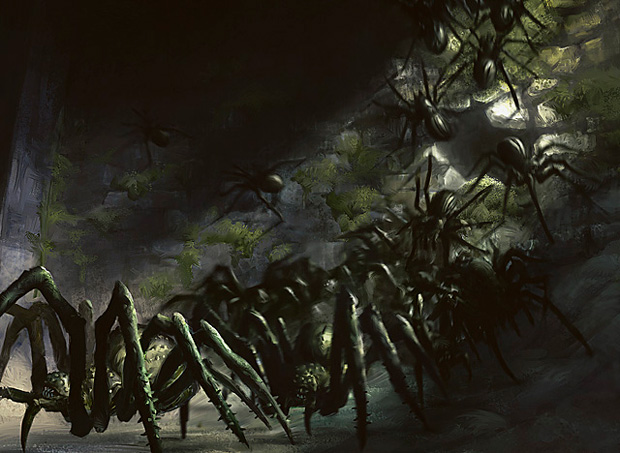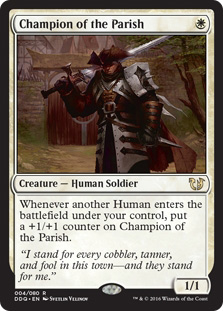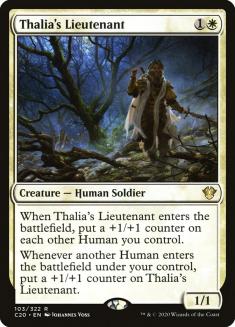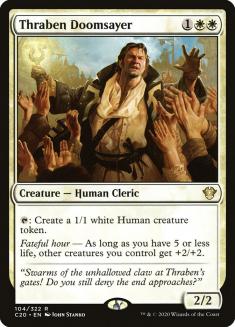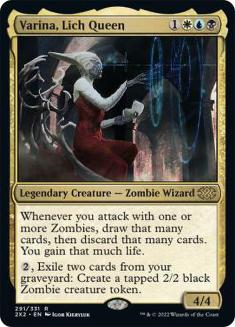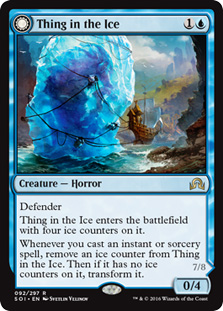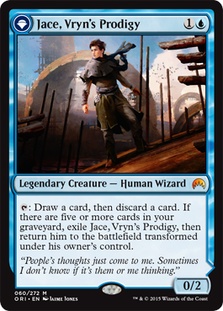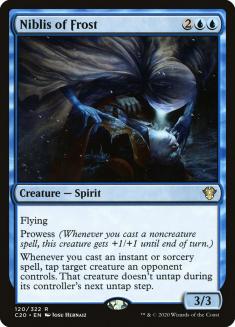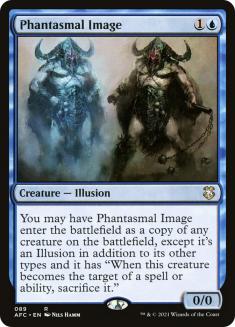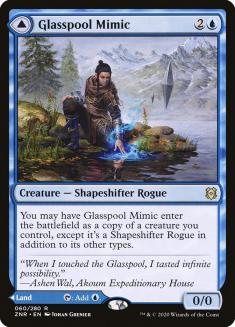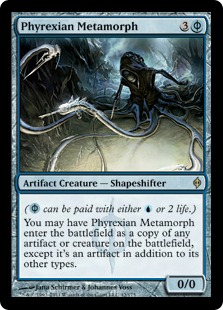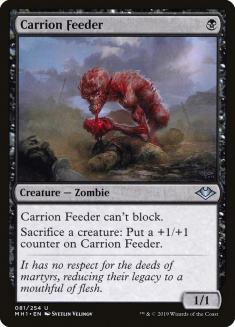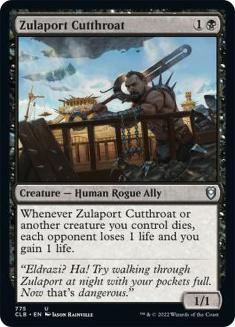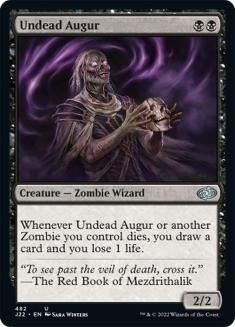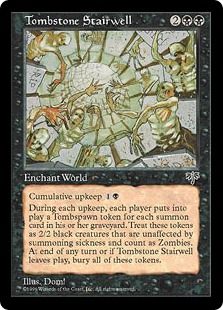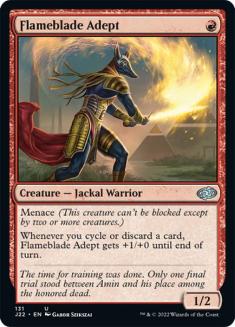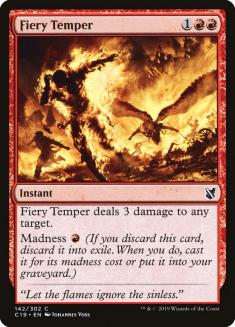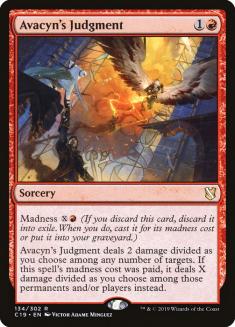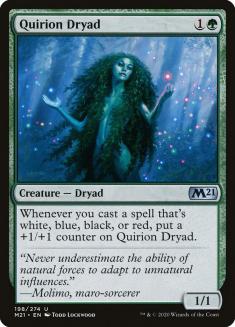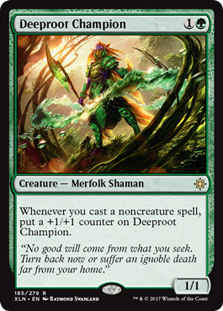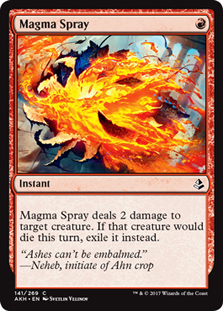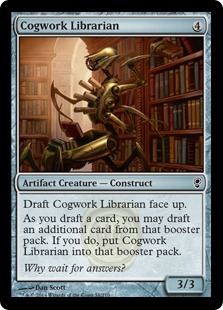Halloween is this Saturday, and spooky season is in full swing. The chatter around pumpkin spice this year has been more muted than previous years, but the various Innistrad queues cycling through Magic Online (MTGO) remind me that despite the early snowfall here in Minnesota it is still very much October. In the spirit of the season, I think it appropriate to do an in-depth piece on my beloved Spooky Cube.
Like many Magic players, I have a lot of nostalgia for original Innistrad. The set was dripping with flavor and the draft experience was incredibly deep. I spent many a long night trying to force Spider Spawning decks, though in truth my fondest memories had to do with my graveyard-centric decks that only almost got there. Something about controlling a Burning Vengeance and flashing back a Bump in the Night was simultaneously not at all what I intended to draft and exactly what I wanted to be doing.
Ultimately, it was the release of Shadows over Innistrad that gave me both the motivation and some additional tools to design a Cube that tried to recreate the feeling of exploration that I always felt drafting Innistrad. At this point I’ve drafted the Spooky Cube many times and poured hundreds of hours into this project. I could talk about the Cube endlessly, though I’m optimistic that I can get enough of the point across in one article to inspire some of you to emulate my project or to get started on a major Cube project of your own. Here’s a link to the Cube list, and here’s what you need to know.
Technical Vision
First and foremost, it would be impossible to pay homage to Innistrad without employing a heavy graveyard theme. A major theme in the Cube is that the graveyard is a relevant zone in a lot of the games. I ended up using a good amount of cards from Odyssey block to make this work, and the mechanical support for graveyard themes ultimately matters more to me than the aesthetic feel of the plane of Innistrad.
The other major theme that I wanted to capture from drafting Innistrad was the incredibly deep card pool and dynamic pick order. I’ve put a lot of effort into finding ways to make the various themes in the Cube overlap in a way that makes hybridizing strategies possible and in a way that makes the themes of the Cube viable in the most possible colors. This is another point where a lot of inspiration comes from Odyssey where the madness mechanic paired incredibly well with threshold and other graveyard synergies. Madness made a comeback in Shadows over Innistrad to enable some synergies as well, though I’ve spent a lot more time looking over Odyssey block for inspiration than Shadows block.
My goal is for the draft portion to be an exercise in finding synergies and for the games to be an exercise in exploring them. The gameplay is heavily skewed towards rewarding being proactive with a solid mix of interactive cards so that you’re not automatically overwhelmed if your opponent drafts more powerful synergies. In many ways, the gameplay of the Cube emulates the matches between what I believe to be the best Modern decks. You’ll also find a lot of similarities to this element of the Cube’s design in Emma Handy’s Proliferate Cube.
My mantra for the Cube is that games should be about decks, not cards. To put that another way, I want players to be rewarded for committing to enabling synergies and investing in payoffs. I’ve cut a lot of cards from the Cube over time for being too big of payoffs without requiring enough setup. Managing power level becomes a lot more difficult when you work on nontraditional Cubes, and this is a very involved part of the design of Spooky Cube that I pay attention to whenever we draft. I’ll come back to this point with some specific examples later.
Aesthetic Vision
This is where I break more solidly from Innistrad. It’s fairly common for players to build Cubes that only use cards from specific blocks and sets. It’s less common, but it happens somewhat regularly where you’ll see somebody design a set themed heavily around existing sets that use cards from other sets as well. An example of this would be Elliot Raff’s Khans Expanded Cube. Personally, I have a few too many nostalgic itches to scratch and I abandoned any strict adherence to an Innistradian aesthetic early in my design of the Spooky Cube.
I didn’t want to dance around the Eldrazi coming to Innistrad; for that matter, I didn’t want to care about the creature types that could or could not be found on Innistrad at all, and I didn’t want to call my Cube “The Innistrad Cube” because it would cause players to make too many assumptions about what the play experience would be.
For one reason or another I started referring to the Cube as Spooky Cube even though I thought that was a pretty goofy name at first. Over time I grew to like the name more and more as the project took on a life of its own. The major aesthetic principle that I held onto from Innistrad was making the environment about Humans surviving in a world overrun with monsters.
Part of what this means is that life is going to be pretty tense for Humans, and I wanted to capture a lot of this tension in drafting and gameplay. Heavily promoting a lot of overlapping synergies plays into this tension very well, because a lot of decisions in-draft and in-game are anything but obvious.
The Colors
A lot of the conversation about drafting more traditional Cubes ends up centered around drafting lands highly, and I find that profoundly boring. I want Spooky Cube to support overlapping synergies and I want to reward my players for trying things. As such, there’s an abundance of powerful lands in Spooky Cube to enable players to draft three- or more-color decks, and there’s even one card in the Cube for every three-color set. This would be problematic and enable five-color good stuff decks in a lot of Cubes, but the heavy emphasis on synergy tends to keep players in two or three colors.
I initially had 50 multicolor lands in the Cube, but I ended up adding another ten because one of the more common ways that a player would derail their draft was by drafting lands too highly. The lands in the Cube beyond the initial fetchlands, dual lands, shocklands, and creature-lands are catered to the decks I expect players to draft, with cycling lands, fastlands, and Horizon lands all making an appearance. This environment is really punishing if your deck doesn’t end up highly synergistic, and just making lands easy to draft is one measure I’ve implemented to save players who are afraid of committing from themselves.
Another similar element of the Cube’s design is that there are very few artifacts. Staying open is a fool’s errand in Spooky Cube, so colorless cards don’t do anybody any favors. The colorless column is short, and the cards in it are there to support specific archetypes and/or to enable delirium.
Each of the five colors heavily support its own theme in the Cube and then offers support cards for some or all of the other colors’ themes as necessary and possible.
White
White has the worst support for graveyard synergy of the five colors of Magic by a very wide margin. Spooky Cube has some awesome Rally the Ancestors decks, but for the most part white is the base color for Humans tribal, which I offered some expanded thoughts on in my article about party in Cube.
The Humans deck is actually responsible for a couple of power level cuts, thought the issue tended to be that some of the best Humans can just show up in any deck and win games easily on their own. Hero of Bladehold and Hanweir Garrison are a couple of examples of creatures that were great Humans but were a little too good at being creatures you would win with if you untapped in any strategy.
White dips its toes into the “spells matter” theme that’s centrally focused in blue, though Monastery Mentor was one of those cards that had a way of completely taking over too many games as long as the deck around it was remotely functional. White does offer powerful exiling effects like Swords to Plowshares and Path to Exile though, which is the primary form of graveyard hate in the Cube. It’s really unfun to make the Cube heavily about the graveyard and then to load the Cube up with heavy-handed hate, but these exile effects offer interesting counterplay.
Azorius (and by extension Bant) is the color set that I’m least happy with in the Cube, which cascades from white being bad at graveyard things and Azorius offering some good Humans but no real thematic Human cards. Currently Bant offers a fairly minor blink theme, though this theme has resulted in a number of cards being cut from the Cube given that creatures with enters-the-battlefield abilities are generally just a powerful category of card. I’m generally a fan of Karmic Guide and Restoration Angel, but for this environment they offered too much while asking too little. Soulherder has been very powerful in the Cube, but it offers a play pattern that I’m far more interested in preserving, given its fragile body and need for investment over multiple turns.
White has an interesting relationship with the Zombie tribe, in that Varina, Lich Queen is one of the three-color cards in the Cube that I like a lot, but no mono-white Zombies ended up making the cut. Unsettled Mariner, Tidehollow Sculler, and Wayward Servant do a lot of the heavy lifting in making the white Zombies decks exist, and for the most part I’m happy having a more niche archetype that’s heavily driven by gold cards as opposed to using monocolored slots to support something that isn’t viable without the gold cards anyway.
Blue
The central theme in blue is “spells matter.” Really original, I know. The implementation here is a bit out of the ordinary for Cube though, in that the spells-matter decks are more focused on assembling creatures with prowess or similar abilities. Ultimately very few of the noncreature cards for these decks provide significant card advantage on their own, which is the result of cutting many of the more powerful individual cards for these archetypes over time in the interest of more balanced gameplay.
I’ve kept in most of the roster of cheap cantrips to support these decks, as these cards are powerful in a way that doesn’t just end the game and also because cards like Ponder will be contested by other drafters in a way that the more powerful thematic cards wouldn’t be. I’ve easily cut more cards for this archetype from the Cube than any other. I was probably wrong to ever try Gush, Snapcaster Mage, and Fact or Fiction, but you know, you do it for the science. Brainstorm amusingly ended up being cut for its interaction with Chasm Skulker and Lorescale Coatl more than anything. I thought Rise from the Tides might be cool. I was wrong. It was just game-ending and boring every time.
Ultimately, the spells matter archetype landed at an appropriate power level when I tied it heavily to red’s madness theme. The synergies that you can hit when you combine looting effects with cards that care about discarding require heavy investment and are really cool, and moving towards looting over inherent card advantage did a lot to make the pick order for these decks more dynamic.
Blue offers some powerful Humans and Zombies, but also adds a lot to the tribal decks in the form of Clone effects. You can only draft one Thalia’s Lieutenant, but you can Clone it several times if things line up right. The Clones also play well with the blink theme and are really just generically good cards.
Black
Black is the primary color for Zombies, and much like white it provides some good support for Humans as well. There’s a sacrifice subtheme, but I’ve kept the sacrifice outlets and effects that care about sacrificing to the two relevant tribes so that the tribal synergies don’t just get drowned out by the better sacrifice cards.
Black offers a lot of support to the madness decks and is generally the best pairing with green for the self-mill decks. I actually need to pack more basic Swamps with the Cube than any other basic given that black is typically the most contested color. This isn’t surprising for a graveyard-centric environment, and is not something that I consider to be a problem. I wouldn’t like it if the black decks came together the same way every time or if I got the sense that playing against black in the Cube was somehow deflating, but that hasn’t been the case. Rather, black is the home for the most crowd-pleasing card in the Cube in Tombstone Stairwell.
Your mileage may vary, but my friends love this card. Amusingly, Tombstone Stairwell didn’t win a lot of games in early runs of the Cube, but all the same it almost never gets passed and somebody is always willing to try it. I firmly believe that a Cube designer should try to make the cool thing the good thing, and as such there are a lot of cards in the Cube that combine nicely with Tombstone Stairwell.
Red
Red offers the primary base for the madness decks as well as offering solid Humans and spells-matter support. There aren’t all that many cards with the madness mechanic actually in the Cube, but there are a lot of cards that care about discarding and madness is just a more fun name for the theme.
Madness isn’t a very common Cube theme given that sets that support the mechanic are somewhat few and far between. I like where the madness decks are in the Cube now, though amusingly it was an archetype that also involved some scaling back of the power level. Violent Eruption played too much like Plague Wind too often, and Drake Haven was a card that I included for a long time but ultimately cut because there was no reason for the madness decks to try to win any other way besides grinding opponents out. Cutting these cards did a lot to let cards like Flameblade Adept and Glint-Horn Buccaneer breathe.
On the topic of the madness theme, Anger and Wonder are somewhat inarguably the two most powerful cards in the Cube. There might come a day when I cut them, but honestly something always ends up being the best and at least Anger and Wonder are extremely cool.
The Gruul cards in the Cube have always featured multiple Werewolves, though they were initially included because they’re Humans. The printing of Nightpack Ambusher in Core Set 2020 actually ended up making Gruul Werewolf Flash into a legitimate deck you could draft and is something that I’ve been very happy with. Ulrich of the Krallenhorde might look a bit weak at a glance in the Gruul section, but the card actually performs well in the Humans and Werewolves decks and involves more investment than Wolfir Silverheart, a card that I cut from the Cube for being too impactful without asking enough of the caster.
The last card I’d like to give specific attention to in red is Pardic Arsonist. In many ways, Pardic Arsonist sums up everything that the Cube is about in one card. It’s impossible to talk about the card without inviting the comparison to Flametongue Kavu, and for traditional Cube play the include would be FTK and there wouldn’t be much of a conversation to have. But Spooky Cube is a place where more obscure cards are celebrated and the games are all about investing in something, and more often than not Pardic Arsonist performs the same as or better than FTK in actual games. I talk about cards that I cut on power level a lot, though on balance the power level of the Cube remains high. There aren’t necessarily effects that are out of bounds, but I will often make you work for the more desirable ones.
Green
Where would we be without the color that gave us Spider Spawning? Green has a robust self-mill theme which powers Spider Spawning as well as delirium. I haven’t had to cut many cards from the self-mill decks on power level, though Kessig Cagebreakers stands out as a card that won any game where it got to attack once, which is a lot less interesting than the way the decks currently play.
Green has good Humans as well, and offers some spells-matter support that far predates Innistrad.
One of my favorite archetypes in Spooky Cube is what long-time players would know as “Grow.” Quirion Dryad serves as a great creature for the spells-matter decks as they’ve come to exist from careful curation, and Vines of Vastwood and Blossoming Defense are really powerful protection spells when your spells-matter deck cares about creatures that also play nicely in the Humans decks.
Tarmogoyf is a pretty typical Cube staple, but the Goyfs in Spooky Cube are much bigger than you typically see elsewhere given the delirium theme. Mishra’s Bauble and Nameless Inversion don’t show up in many other Cubes, but they’re right at home alongside Tarmogoyf and Inexorable Blob.
A pretty important element of green’s design in the Cube is that all of the fast mana is thematic. Avacyn’s Pilgrim, Noble Hierarch, and Werebear are all Humans, and alongside Elves of Deep Shadow are all great bodies for supporting the Spider Spawning deck. Arixmethes, Slumbering Isle is a personal favorite of mine that plays well in the Simic spells-matter decks as well as bridging the gap to cast the Temur gold card in Maelstrom Wanderer, which despite being a Commander product release is one of the coolest cards ever printed.
Keeping Things Grounded
I’ve mentioned a few cards like Tarmogoyf, cheap cantrips, and Swords to Plowshares as more generic Cube cards being featured in Spooky Cube, and I think that some of that is essential for making an accessible Cube experience. I never feel more lost as a player than when I have to read a lot of cards in a pack, so I find it important to feature a healthy amount of cards that have seen competitive play historically. You want the environment to be unique, but not so much that it doesn’t feel like you’re playing the same game.
Lightning Bolt is just a great, generically powerful card, but that doesn’t mean it’s not worthy of an inclusion here. In fact, its presence can actually have a pretty illuminating impact on some draft decisions. With all of the graveyard-matters themes, it’s not immediately obvious whether Magma Spray or Lightning Bolt is better in the average deck, and the times where a player picks Magma Spray over Lightning Bolt make for pretty cool experiences.
Drafting the Cube
As I’ve said, Spooky Cube is a heavily synergy-driven environment. The Cube rewards committing to synergies and to exploring the implications of the way the cards you’ve already drafted influence your future decisions. Given that the Cube is so reliant on synergies, I’ve actually come up with a house rule for drafting the Cube that helps players carve out their position in the draft. If you’re a Conspiracy fan, you’ll be familiar with the card Cogwork Librarian.
The rule is that each player starts with a Cogwork Librarian in their pool. That means that if you think two cards in your first pack will go really well together, you can cash in your Librarian and take them both. It’s a pretty simple rule to implement, and a ton of fun. Some players are initially hesitant to cash in their Librarians, but this actually works best when players are aggressive with them because that means that there will be more Librarians circulating in the draft and you’ll get to use them more often as they come back to you.
Sadly, there will be no Spooky Cube draft this Halloween, but I am very grateful for this opportunity to share this design with you. The Spooky Cube has been my most involved endeavor into Cube design, and I’ve learned so much working on this project. I intend to toss some Spooky Cube Pack 1, Pick 1s up this week on Twitter, so keep an eye out for that and feel free to send any Cube thoughts and/or questions my way @RyanOverdrive.

